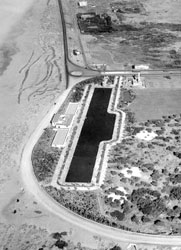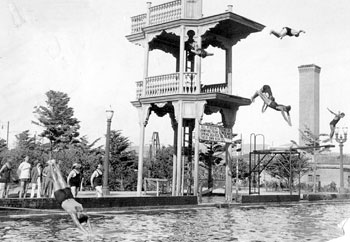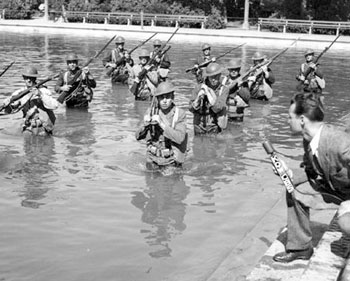The following was first published by Jim Smith in Guidelines, a newsletter for San Francisco City Guides and Sponsors

The name Fleishhacker invoked visions of fun at the beach — Fleishhacker Playground
for amateur baseball, Fleishhacker Zoological Gardens, and Fleishhacker Pool. "When
I was a kid, we would dive off the top platform. It must've been thirty feet
up." — Robert W. Smith, father of the author. Fleishhacker Pool was an attraction
that was unique to San Francisco. It rightfully claimed its status as the
world's largest heated salt-water pool. The pool measured 1000 feet in length
by 160 feet across at the middle section and 100 feet across at each end. The
depth graduated from 3 feet at the west end to 15 feet under the diving platform. It
held 6,500,000 gallons of filtered seawater pumped in from the Pacific Ocean and
could heat 2800 gallons a minute from 60 to 75 degrees Fahrenheit. The pool maintained
the constant 72 degrees required for A.A.U. (Amateur Athletic Union) Swim
Meets. Unfortunately, when the ambient air temperature is in the 60s or lower
with a damp breeze coming off Ocean Beach, that's a cold 72 degrees.
Fleishhacker Pool was a gift to San Francisco by financier and city Parks
Commissioner Herbert Fleishhacker. He also made the initial donations of land
and money for the playground and zoo. The pool was built to attract athletic
competition to the city and because the waters off Ocean Beach are consistently
cold year around. John McLaren, designer of Golden Gate Park and park
superintendent, conceived the plan, receiving strong backing from the Parks
Commission and Mr. Fleishhacker, its President.
The Fleishhacker Municipal Swimming Pool opened on April 22, 1925, as host to
a national A.A.U. Swim Meet with five thousand attending the event to watch
the competition. Johnny Weissmuller, the world champion freestyle swimmer, represented
the Illinois Athletic Club. He later went on to a career in action films--Tarzan
being his most notable role. Weissmuller made a number of later appearances
at Fleishhacker, always drawing a crowd. San Francisco adopted him as one of
their own. Other celebrities appearing often at Fleishhacker Pool included
Ann Curtis, who set a number of world records, and movie star Esther Williams. She
first appeared in Billy Rose's Aquacade opposite Weissmuller in the 1940 Golden
Gate International Exposition at Treasure Island.

The pool opened to the general public on May 1, 1925, with 5000 bathers paying
25 cents, 15 cents for swimmers under 12 years of age. That fee purchased
admission, use of the grounds, including a large dressing room with showers, plus
the loan of a bathing suit and large towel, sterilized between uses. A San
Francisco Chronicle news report estimated that fewer than half the bathers
could swim, but all seemed to have a great time. The pool had 12 lifesavers on
duty, as well as a number of life saving rowboats on patrol. It also sported a
tree-sheltered beach, a cafeteria, and a childcare area in the main building.
Mayor Rolph named the entire complex for Fleishhacker in recognition of his work
for and his dedication to the people and especially the children of San
Francisco. The city strongly promoted the pool, sponsoring athletic
competitions and exhibitions. Still, the pool failed to pay its own way. Ocean
Beach was rarely much warmer than 70 degrees, even if the water was 72 degrees,
which everyone doubted. After the novelty wore off, attendance fell, with the
exception of special events.

Plans were drawn and redrawn to scale down the size of the pool to save heating
and overhead costs. The pool remained the largest in the world, and in 1943, while
American troops used it for training toward amphibious beach assaults, politicians
were carving it up. Nothing came of the politician's efforts except the installation
of a chain link fence in an attempt to funnel people through the pay
gates. Under-funded, Fleishhacker Pool slowly slid into a state of mild
disrepair. A January 1971 storm proved to be the final blow. The outflow pipe
that disposed of the used pool water collapsed, and the cost of repair exceeded
the department's ability to pay. An attempt to convert it to fresh water proved
futile due to uncontrollable algae growth, and the pool closed forever in June of
that year. The concrete was broken out and the hole filled with rubble and
topsoil. The city granted the land to the San Francisco Zoo (formerly Fleishhacker
Zoological Gardens). The intention was to add badly needed parking and a restaurant, but
to this day they lack the funds to undertake this project.
